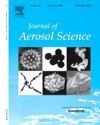Bipolar coagulation in bipolar electrosprays: Optimizing coagulation efficiency and hetero-agglomerate composition
IF 2.9
3区 环境科学与生态学
Q2 ENGINEERING, CHEMICAL
引用次数: 0
Abstract
This work investigates the bipolar coagulation of oppositely charged nanoparticles, a few nanometers in size, generated by a bipolar electrospray. These particles form after highly charged droplets produced by the electrospray evaporate, carrying a fraction of the initial droplet charge. The particle charge fraction depends on the non-volatile volume fraction of the feed solution. However, during evaporation, ions and charged clusters form that carry the remaining droplet charge, competing with particle-particle coagulation and thus reducing coagulation efficiency. To enhance coagulation efficiency, the non-volatile volume fraction of the feed solution was increased by adding diethylene glycol (DEG). Additionally, the number of salt particles in the agglomerates was tuned by changing the conductivity ratio of the feed solutions. Experiments were conducted using glucose and sodium chloride particles as a model system for material based applications. Notably, glucose evaporates completely from the coagulated particles, making this system suitable for our tandem DMA setup with a tube furnace between the two DMAs. This setup allowed us to obtain 2D distributions containing information on agglomerate concentration and composition and to optimize coagulation efficiency.
双极电喷雾中的双极混凝:优化混凝效率和异质团聚物组成
这项工作研究了极性电喷雾产生的几纳米大小的带相反电荷的纳米颗粒的双极性凝固。这些粒子是在电喷雾产生的高电荷液滴蒸发后形成的,携带着初始液滴电荷的一小部分。颗粒电荷分数取决于进料溶液的非挥发性体积分数。然而,在蒸发过程中,离子和带电团簇形成,携带剩余的液滴电荷,与颗粒-颗粒混凝竞争,从而降低了混凝效率。为了提高混凝效率,通过添加二甘醇(DEG)来提高进料溶液的非挥发性体积分数。此外,通过改变进料溶液的电导率来调节团聚体中盐颗粒的数量。实验使用葡萄糖和氯化钠颗粒作为基于材料应用的模型系统。值得注意的是,葡萄糖完全从凝固的颗粒中蒸发,使该系统适合我们的串联DMA设置,在两个DMA之间有一个管状炉。这种设置使我们能够获得包含凝聚体浓度和组成信息的二维分布,并优化凝聚效率。
本文章由计算机程序翻译,如有差异,请以英文原文为准。
求助全文
约1分钟内获得全文
求助全文
来源期刊

Journal of Aerosol Science
环境科学-工程:化工
CiteScore
8.80
自引率
8.90%
发文量
127
审稿时长
35 days
期刊介绍:
Founded in 1970, the Journal of Aerosol Science considers itself the prime vehicle for the publication of original work as well as reviews related to fundamental and applied aerosol research, as well as aerosol instrumentation. Its content is directed at scientists working in engineering disciplines, as well as physics, chemistry, and environmental sciences.
The editors welcome submissions of papers describing recent experimental, numerical, and theoretical research related to the following topics:
1. Fundamental Aerosol Science.
2. Applied Aerosol Science.
3. Instrumentation & Measurement Methods.
 求助内容:
求助内容: 应助结果提醒方式:
应助结果提醒方式:


